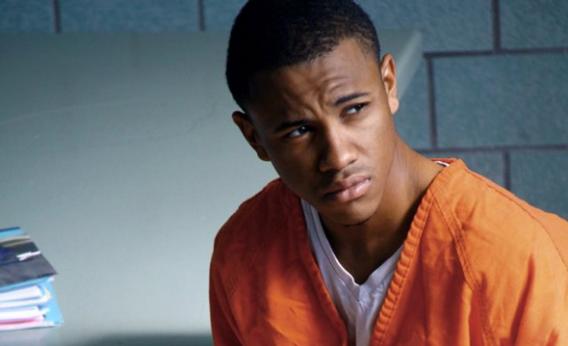Blue Caprice
The Beltway snipers movie is spare, eerie, and insubstantial.

Courtesy of IFC Films
After you’ve seen Blue Caprice, come back and listen to our Spoiler Special:
It’s very clear what the French-born, U.S.-based director Alexandre Moors was trying not to do in his first feature, Blue Caprice, which tells the story of the “Beltway snipers” who terrorized the Washington, D.C., area for three awful weeks in the fall of 2002, killing 10 people and critically wounding three others. Moors didn’t set out to make an explicit, factually accurate account of the crimes—rather, his approach is elliptical and allusive, given to sudden shifts in time frame and long, often dialogue-free takes of the blighted American landscape through which his antiheroes move. Nor did Moors want to shock the viewer with graphic images of violence: Blue Caprice’s depiction of the actual killings is so non-exploitative it’s almost muffled, as the crimes for which the whole movie has prepared us flash by in a hasty montage at the end. What’s less obvious is just what the director did set out to do. For all its tasteful spareness and eerie, diaphanous mood, Blue Caprice feels, in the end, insubstantial. It’s a true-crime story that illustrates little about the crime in question and a character study whose characters, even when haunting, remain stubbornly opaque.
That opacity is in part inevitable, given that no one has yet fully understood the motives of John Allen Muhammad, the middle-aged man who masterminded the random shootings, and Lee Boyd Malvo, the teenage boy who, for the most part, carried them out. When Muhammad was executed by lethal injection in 2009, he refused to make a final statement, and Malvo, who is serving six consecutive life sentences, has said (in an interview that took place 10 years after the killings) that “there [was] no rhyme or reason or sense.” But Moors’ close-up portrait of the relationship between Muhammad (Isaiah Washington) and Malvo (Tequan Richmond) always seems just on the edge of revealing some truth about their toxic bond that it never quite delivers.
After a prologue made up of real-life media coverage of the D.C. shootings, the film takes us back in time to the Caribbean island of Antigua, where the teenage Lee is abandoned by his mother and then saved from (possibly intentional) drowning by Muhammad, who’s vacationing there with his three young children. (In real life, Malvo and his mother befriended Muhammad together, and she left her son in the older man’s care.) Later, Muhammad brings Lee back to the U.S. (again, a significant compression of real-life events), now passing him off as his son. Muhammad is forbidden to have contact with his three real children after his ex-wife takes out a restraining order against him, leaving him increasingly isolated and bitter. Meanwhile, he begins to train his quasi-adopted son as both a marksman and a crackpot, giving him a military-sniper training manual to read and outlining a vague plan to bring down “the system” through a series of random crimes.
In the movie’s weakest section, Muhammad and Lee drift around Tacoma, Wash., first crashing on the couch of one of Muhammad’s girlfriends and later at the home of his old Army buddy, Ray (Tim Blake Nelson) and Ray’s wife (Joey Lauren Adams.) Ray is a gun nut with lax safety standards, which allows his houseguests access to a whole garage full of heavy weaponry. Moors and his co-screenwriter, R.F.I. Porto, drop hints about how and why Muhammad and Lee’s aimless discontent congeals into murderous rage; we see Lee absorbed in a first-person shooter video game, and watch as John tries various ruses to find out about his ex-wife’s and children’s whereabouts. There’s a frightening scene in which the older man ties the younger one to a tree in the woods, forcing him to escape and make his way home in an apparent attempt to break his spirit and make him more dependent and pliable. But Lee’s transformation from damaged orphan to cold-blooded killer is so imprecisely delineated that later in the film, when Muhammad observes with chilling pride that “I’ve created a monster,” the viewer feels the need to rewind to figure out just when, and how, such a thing could have happened. It’s only Washington’s and Richmond’s quietly disturbing performances (Richmond’s is all the more impressive given his near-total lack of dialogue) that sustain the film’s tone through this creepy but momentumless middle section.
Moors has said that his original plan was to end the story just before the Beltway killings took place, and perhaps he should have. A late scene in which the killers’ specially tricked-out vehicle—the blue Caprice of the title—drives slowly down the highway toward D.C. over the sound of mournful choral wailing would have made for an appropriately ambiguous ending. But the rushed montage that follows, in which we get a few unsettling glimpses of the results of the killing spree with no sense of how many people died or over how long a period (not to mention what Malvo and Muhammad did, thought, or said in between murders) makes for a frustratingly abrupt conclusion to this slim 93-minute film. I understand Moors’ impulse to avoid both tidy moral explanations and sensationalistic gore, but we don’t spend long enough with either victims or perpetrators to get a sense of what those terrible few weeks in Washington were like.
The elegant, monochromatic cinematography by Brian O’Carroll often uses extreme soft-focus effects, allowing the blurred figures in the background of a shot—usually, Muhammad and Lee themselves—to emerge very slowly into sharper focus as they approach the lens. It’s too bad that Moors and Porto’s script relies so heavily on a kind of reverse effect: The closer Blue Caprice gets to the two killers at its center, the less we understand them.
